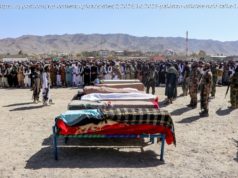The ban has been tamed. So has the resistance to it.
Donald Trump’s travel ban, in its third iteration, has been upheld by the Supreme Court in an opinion (written by Chief Justice John Roberts) that all but declares: This is normal.
Roberts’ opinion is a defense of the established process by which the most recent version of the ban was designed and implemented; of the rationales the administration offered to the Court for it that didn’t have anything to do with the “Muslim ban” Trump proposed as a candidate.
The Supreme Court’s decision barely seemed to inhabit the same reality of the week in January 2017 when the first travel ban turned America upside down.
But then again, the ban itself changed over that time — and so, really, did the reality around it.
Think back to January 2017 — the first week of Trump’s presidency, when he signed an executive order banning all entries to the US from people from seven Muslim-majority countries and nearly all refugees from around the world on a Friday afternoon. It was implemented around the world barely four hours after its text was made public — with no time for the various agencies involved in its implementation to even get on the same page about who, exactly, was banned under the executive order, much less train the field operatives enforcing it on the ground.
And immediately, it felt like something fundamental about the country had changed.
On Friday night, people were pulled out of boarding lines in European airports. By Saturday, dozens of people landed in American airports and were immediately taken into detention. It was eventually revealed that at least 750 people were detained under the ban, though at the time, the government wouldn’t even divulge how many airport detainees there were. Members of Congress had to show up at airport terminals to demand information about who was being held by Customs and Border Protection agents; reports of agents disobeying federal court orders rippled through Sunday night.
Hundreds of thousands of green card holders — legal permanent residents of the US — became terrified of leaving the country out of fear they wouldn’t be allowed to return; it took nearly a week, and multiple mixed messages, for the Trump administration to confirm that the ban didn’t apply to them. American communities waiting to take in refugees had to box up their hopes as their new neighbors’ arrivals were delayed for weeks or potentially for good.
The epic rupture brought epic resistance. Pro bono law clinics sprang up in airport terminals; massive spontaneous protests erupted outside them. The American Civil Liberties Union collected $24.1 million in donations over a single weekend. World leaders condemned the administration; so did corporate leaders; so did religious leaders. Some Republicans criticized their party’s new president; many retained an (apparently embarrassed) silence. Lawyers swept into court for emergency hearings, first fighting to limit the government’s powers to detain immigrants under the ban and then, within a week, putting the ban on hold entirely.
The travel ban was the purest possible example of a truth that Trump’s opponents had already turned into a slogan: This Is Not Normal.
Then, slowly but surely, it became just that.
Trump’s travel ban, now in its third iteration, is currently being enforced in full; it’s been in effect since December. And thanks to the Supreme Court’s ruling, it will remain in place indefinitely.
But the months in which we’ve had the travel ban have barely made a ripple.
During oral arguments in April on the travel-ban case, the protest outside the Supreme Court numbered a couple hundred people — exactly what you’d expect for a high-profile Supreme Court case. The Supreme Court takes up important cases that many people care about every year; Trump v. Hawaii was just the latest in a long list of those.
There was nothing in Roberts’ decision to suggest that the travel ban had ever been much more than a typical political debate.
Both of the things that made the last days of January 2017 feel so abnormal — the excesses of government caprice and cruelty, and the unstoppable outpouring of resistance energy from all sectors of society — have become invisible to the naked eye.
That doesn’t mean they’ve disappeared. But it means they’ve become normal — that both the ban and the resistance to it have shrunk to the point that they can easily be encompassed within the typical scope of “political issues,” not a fundamental shift in American daily life.
While the court battle has raged throughout all three versions of the travel ban that the Trump administration has implemented or tried to implement — the January 2017 executive order, a replacement executive order issued in March 2017, and a September proclamation that set up the current, indefinite ban — the policies in the ban have changed substantially. And it’s hard to deny that the current version of the ban is much, much more moderate than the first.
The initial travel ban covered seven countries, all of them majority Muslim: Iran, Iraq, Libya, Somalia, Sudan, Syria, and Yemen. It included permanent residents of the US (at least until the administration clarified it didn’t). It included Iraqi citizens who had served as translators in Iraq, and Christian families attempting to flee persecution. It covered refugees from around the world. It allowed people arriving in the United States, with valid visas, to be detained and sent back once they got here. It made no exceptions and showed no mercy.
The current ban covers five of the seven originally banned countries — Iraq and Sudan have been dropped — in addition to Venezuela and North Korea (whose bans aren’t being challenged in the lawsuit). It exempts green card holders and anyone who held a valid visa to come to the US as of the date the proclamation was issued. Foreign students are all but exempted from the ban (among the five banned Muslim-majority countries, only one ban — Syria — includes student visa holders). Temporary foreign workers from Libya, Somalia, and Yemen are allowed in. And (at least in theory) any visa applicant has a shot at a waiver from the ban, if the US decides admitting her is in the country’s best interest. And there’s no longer a refugee ban to go along with the country-based ban.
It’s hard to quantify the relative scope of the bans because the US doesn’t keep precise numbers on how many people are admitted to the country in total each year, or how many people currently live in the US on a particular immigration status. So it’s impossible to know for sure the number of green card holders who were in danger if they left the US under the first ban but are now safe.
But even just looking at the numbers the government does keep — admissions of nonimmigrants (temporary visa holders) and refugees — the people targeted by the first version of the ban made up 160,418 admissions during fiscal year 2016. The people targeted by the ban in place now make up fewer than 70,000 — less than half of the original ban’s scope.
These changes are almost entirely the result of the Trump administration’s attempt to build a court-proof travel ban. The current version is as close to court-proof as a policy signed by the man who once called for a “ total and complete shutdown of Muslims entering the United States” could possibly get. While that means it’s likely to stay in place, it also represents a victory for the ban’s opponents. The courts (perhaps inspired by the resistance in the streets) forced the administration to keep its ambitions within the scope of what was legally permissible, and the administration complied. The system worked.
What made the first travel ban feel so abnormal wasn’t the actual policy, but the way that policy was implemented: The authoritarian chaos of the airports seemed to herald an era in which the government was fundamentally unpredictable and fundamentally unaccountable.
The spectacle sparked a counterspectacle: the airport protests, with thousands of Americans schlepping out to show solidarity for people they’d never met. That made it harder for courts to dismiss the lawsuits against the ban by saying the national interest justified sweeping executive power.






